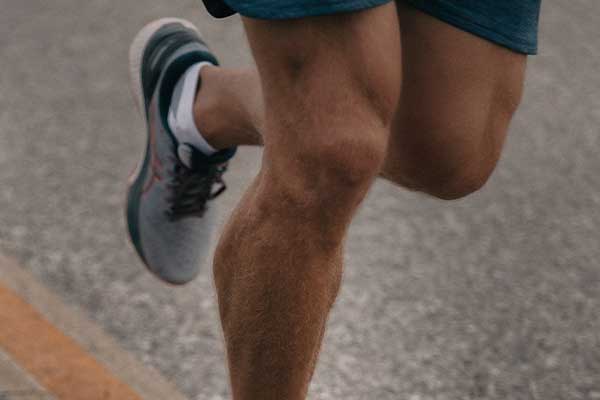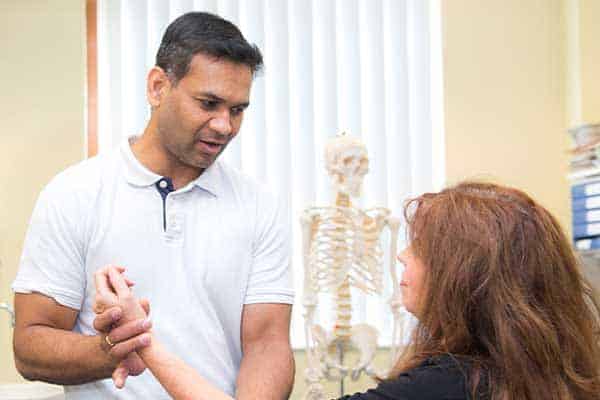Quadriceps muscle injuries are injuries to the main bulk of muscle on the front of your thigh. The most common types of injury are strains/tears and contusions (bruising).
The quadriceps muscles work together in a group of four. They help you to stand, walk, climb and squat and are particularly active in kicking, jumping, cycling and running. This makes them prone to stress and injuries in many sports.
What causes quadriceps muscle injuries?
Quadriceps muscle injuries are frequently caused by overstretching or overloading during sports such as football and rugby, where the injury is often to the kicking leg.
They can also be injured by a direct blow causing bruising to the front of the leg.
What are the symptoms of quadriceps muscle injuries?
Typical symptoms include:
- A sharp, sudden pain that is localised on the front of your thigh.
- Pain experienced during activities such as climbing stairs, getting out of a chair and walking.
- Pain when stretching the front of your thigh, such as bending your knee to sit down.
- Pain when straightening your knee fully.
Depending on the severity of the injury, you may also see:
- Swelling and bruising on the front of your thigh.
How are quadriceps muscle injuries diagnosed?
There are two common types of quadriceps muscle injury:
- Muscle strain, which is graded as follows:
- Grade 1: A mild muscle pull or strain causing pain and tenderness but no loss of muscle strength.
- Grade 2: A partial muscle tear, which might cause swelling and bruising as well as some loss of strength.
- Grade 3: A ‘complete’ muscle tear/rupture, with over 50% of muscle fibres torn. This will usually be very painful, tender, swollen and bruised, and you will be unable to use your leg.
- Muscle contusion (bruising) from a direct impact.
There is normally no need to seek an assessment from your GP unless you are concerned that you have a severe injury (Grade 3), or if your symptoms do not improve.
What are the treatment options for quadriceps muscle injuries?
Depending on the severity of your injury, it may be advisable to start moving and strengthening your muscles again, as soon as possible, or to avoid putting any weight on your injured leg (for Grade 3 injuries, your GP may recommend using crutches).
In either case, it is important to manage pain or swelling during the first few days.
Put an ice pack on your thigh for 10-20 minutes, every 2-3 hours, to relieve pain. (Do not put ice directly next to skin as it may cause ice burn. Wrap it in a damp tea towel. Remove the pack if irritation increases. Allow the area to return to normal temperature before reapplying the ice.)
Compress your thigh with a tubular bandage or neoprene support. This can help to relieve pain and reduce swelling. This support must not be worn overnight.
As often as possible, use pillows or cushions to elevate your leg above the level of your heart. This can also help to relieve pain and reduce swelling.
You could try anti-inflammatory painkillers such as Ibuprofen. Some anti-inflammatory painkillers also come as creams or gels, which you can rub over your quadriceps area. These tend to produce fewer side effects than those taken by mouth. If you cannot take anti-inflammatory painkillers, other painkillers such as paracetamol, with or without codeine added, may be helpful. Ask your doctor or pharmacist for advice.
Once the pain and swelling start to improve, you should consider exercises to help your muscles regain their strength. These should be light to start with, such as walking and simple movement exercises, gradually progressing to weight-bearing and strengthening exercises (depending on the severity of your injury).
Your doctor can offer advice or refer you for physiotherapy or other manual therapies.
In very rare cases, if your injury has been particularly severe, surgery may be necessary.
What is the prognosis (outlook) for quadriceps muscle injuries?
Returning to full fitness after a quadriceps muscle injury may take days, weeks or months, depending on how severe it is.
With a good rehabilitation/exercise regime, you can usually recover from Grade 1 and 2 muscle strains, as well as the majority of contusion injuries, within several weeks.
A completely torn quadriceps muscle may take several months to heal and you will be unable to resume training or to play sport during this time.
How can I prevent recurrence of quadriceps muscle injuries?
It is important not to overdo your recovery exercises or to return to sports too early.
However, it is also unwise to avoid exercise, as this can lead to further problems.
Performing regular stretching and strengthening exercises could help avoid future episodes of quadriceps muscle injury. So can warming up properly before exercise.
Recommended exercises (click to expand):
Heel slide
- Lie on your back with your legs straight out.
- Bend your uninjured leg, sliding your heel towards your buttocks and keeping your knee pointing to the ceiling. Hold this position.
- Now bend your injured leg up in a matching movement, as far as it will comfortably go.
- Slide the heel back down until your injured leg is straight again.
- Leaving your uninjured leg bent up, repeat the heel slide with your injured leg.
Static quad contraction
- Sit on the floor with your uninjured leg bent up at the knee and your injured leg extended out in front of you.
- Pull the toes on your injured leg towards you and clench your thigh muscles, pushing the back of your knee down so that your leg straightens.
- Hold this position, relax and repeat.
Straight leg raise
- Sit on the floor with your uninjured leg bent up at the knee and your injured leg extended out in front of you.
- Pull the toes on your injured leg towards you and clench your thigh muscles, pushing the back of your knee down so that your leg straightens.
- Keeping your knee straight by maintaining the muscle contraction, lift your leg off the floor.
- Hold this position for a few seconds before you return your leg to the floor.
- Repeat this movement.
- Make sure your hips remain in contact with the floor at all times and your knee remains straight.
Inner range quad contraction
- Sit on the floor with your legs stretched out in front of you and a rolled-up towel under your knees.
- Using your injured leg, keep your toes pointed upwards straighten your knee by tightening your thigh muscles. Ensure that the back of your knee remains in contact with the towel.
- Hold this position, relax and repeat.
Seated knee extension
- Sit in an upright chair with your shoulders back and your legs bent naturally at the knee.
- Without moving your hips, extend one lower leg straight out in front of you.
- Flex the knee back to the neutral sitting position.
- Switch legs and repeat.
Sit to stand (no arms)
- Sit in an upright chair with your shoulders back and your legs bent naturally at the knee.
- Cross your arms in front of your chest.
- Stand up straight without using your arms to push you up or steady you.
- Slowly sit back down and repeat.
Squat
- Stand with your feet a shoulder-width apart.
- Extend your arms out in front of you and tighten your tummy muscles
- Keep your knees over your toes, keep your weight on your heels and gently squat down.
- As you squat, bend from your hips and keep your back straight.
- At the bottom of the squat, tense your bottom muscles and keep them tense as you straighten back up to the start position.
- Repeat.

How to get referred
Find out how to get referred to Practice Plus Group MSK & Diagnostics for NHS treatment.




